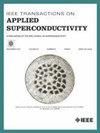REBCO带在后续层沉积过程中的拉伸强度
IF 1.8
3区 物理与天体物理
Q3 ENGINEERING, ELECTRICAL & ELECTRONIC
引用次数: 0
摘要
ReBa2Cu3O7-x (REBCO)胶带在使用中要求高屈服强度;否则,过大的应力会严重破坏其超导性能,甚至诱发淬火。因此,研究影响REBCO胶带力学性能的因素变得至关重要。本研究系统地研究了不同薄膜层(缓冲层、超导层、银层和铜层)沉积过程中REBCO带抗拉强度的变化。结果表明,从裸露的哈氏合金基体到完全制备的REBCO带,屈服强度下降了525 MPa(约37%),REBCO层的高温沉积是导致屈服强度下降的主要原因。利用电子背散射衍射对哈氏合金基体样品进行微观结构分析,发现REBCO层沉积导致哈氏合金基体内晶粒尺寸增大,位错密度显著降低。这种微观结构的转变直接导致了REBCO带屈服强度的整体下降。此外,观察到的哈氏合金基体微观结构的变化归因于涂层过程中使用的过高温度。本研究的发现可能为寻求提高胶带机械性能的制造商提供见解。本文章由计算机程序翻译,如有差异,请以英文原文为准。
Tensile Strength of REBCO Tape During Deposition of Subsequential Layers
ReBa2Cu3O7-x (REBCO) tapes require high yield strength in service; otherwise, excessive stress may seriously damage their superconducting performance or even induce quenching. Therefore, investigating the factors influencing the mechanical performance of REBCO tapes becomes critically important. In this study, the variations in the tensile strength of REBCO tapes during the deposition of various film layers (buffer layer, superconducting layer, Ag layer, and Cu layer) were systematically investigated. The results showed that the yield strength decreased by 525 MPa (approximately 37%) from the bare Hastelloy substrate to the fully fabricated REBCO tape, with the high-temperature deposition of the REBCO layer being the primary contributor to this reduction. Microstructural analysis of each Hastelloy substrate sample, using electron backscatter diffraction, revealed that the REBCO layer deposition led to an increase in grain size and a considerable decrease in dislocation density within the Hastelloy substrate. This microstructural transformation directly contributed to the overall decrease in the yield strength of the REBCO tape. Furthermore, the observed changes in the microstructure of the Hastelloy substrate were attributed to the excessively high temperature employed during the coating process. The findings of this study may provide insights for manufacturers seeking to enhance the mechanical performance of their tapes.
求助全文
通过发布文献求助,成功后即可免费获取论文全文。
去求助
来源期刊

IEEE Transactions on Applied Superconductivity
工程技术-工程:电子与电气
CiteScore
3.50
自引率
33.30%
发文量
650
审稿时长
2.3 months
期刊介绍:
IEEE Transactions on Applied Superconductivity (TAS) contains articles on the applications of superconductivity and other relevant technology. Electronic applications include analog and digital circuits employing thin films and active devices such as Josephson junctions. Large scale applications include magnets for power applications such as motors and generators, for magnetic resonance, for accelerators, and cable applications such as power transmission.
 求助内容:
求助内容: 应助结果提醒方式:
应助结果提醒方式:


